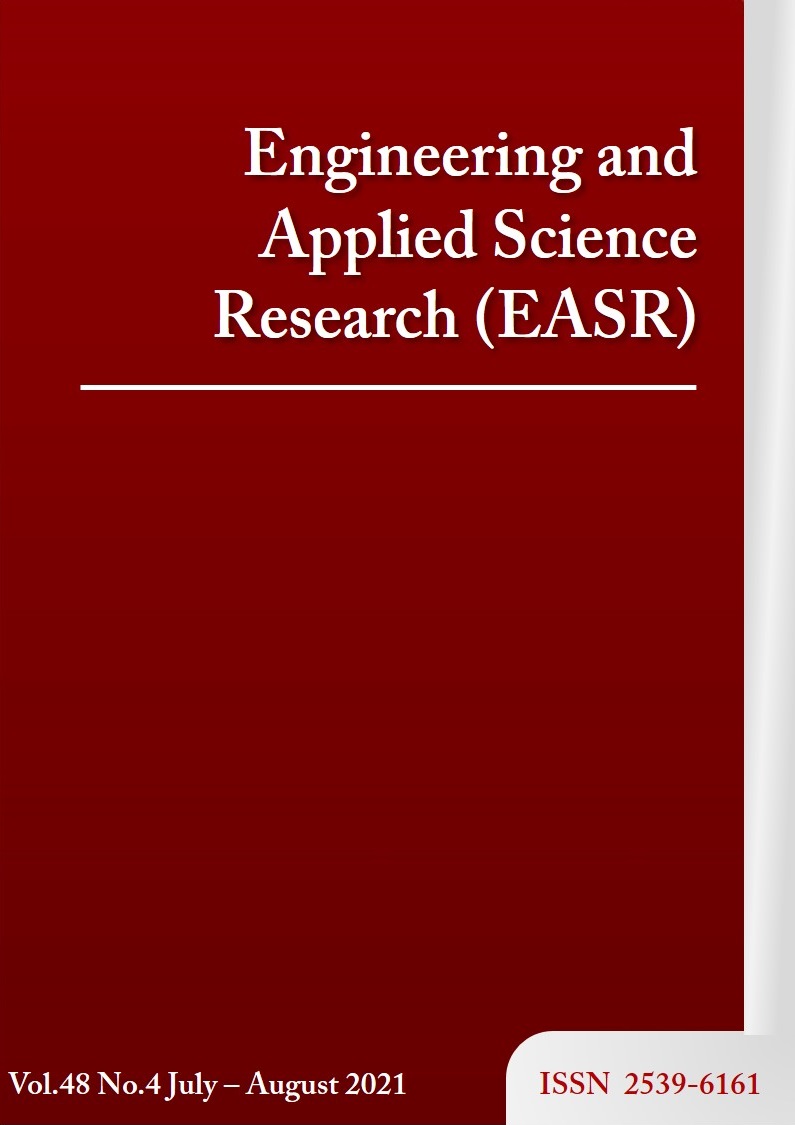Efficiency of renewable plastic material degradation using effective microorganisms in aerobic conditions
Main Article Content
Abstract
Studies were conducted to establish a simulated system based on the aerobic biodegradation of renewable plastic materials (cellulose, Poly lactic acid (PLA), and bio-base). The experiment consisted of carrying out biodegradation by using a reactor. The experiment was tested at 28 days under the following conditions: the control parameter of air flow was 60 mL/min, the humidity was 60-80%, and pH ranged from 7.5-8.5. The results indicated the analytical carbon dioxide (CO2) and weight loss. It was found that the effective microbes had been able to degrade the renewable materials, except for the bio-base. The EM had been able to degrade PLA and Cellulose at 4.51±0.50% and 40.53±2.15, while the weight loss of the PLA and Cellulose had been 5.24±0.85% and 42.65±3.55%. The EM had secreted cellulase enzymes to decompose the cellulose, and the enzymes had caused catalytic reactions, which, in turn, had degraded the cellulose. Because cellulose has organic carbon, the cellulose test showed high degradation. The EM had been able to degrade the cellulose because the EM consisted of aerobic and anaerobic microbes that had contributed to the degradation organic compounds. The result of the observations indicated that cellulose had torn after 28 days. However, the PLA had only slightly changed, while the bio-base had shown no change at all. Moreover, SEM observation showed that the PLA and the cellulose had been damaged. The EM were found to be growing on surface of two materials and were also growing inside of the materials. Meanwhile, no damage was found on the bio-base at all. The EM had been able to degrade the renewable materials. Cellulose is the material with the highest degradation. It is, therefore, possible that EM have the ability to degrade biodegradable plastics.
Article Details
This work is licensed under a Creative Commons Attribution-NonCommercial-NoDerivatives 4.0 International License.
References
Mekonnen T, Mussone P, Khalil H, Bressler D. Progress in bio-based plastics and plasticizing modifications. J Mater Chem A. 2013;1(43):13379-98.
Delaney P. How long it takes for some everyday items to decompose [Internet]. Down2Earth Materials, 2013. [updated 2013 Feb 14; cited 2018 Nov 23]. Available from: https://www.down2earthmaterials.ie/2013/02/14/decompose/.
Emadian SM, Onay TT, Demirel B. Biodegradation of bioplastics in natural environments. Waste Manag. 2017;59:526-36.
Weng YX, Jin YJ, Meng QY, Wang L, Zhang M, Wang YZ. Biodegradation behavior of poly (butylene adipate-coterephthalate) (PBAT), poly (lactic acid) (PLA), and their blend under soil conditions. Polym Test. 2013;32:918-26.
Carole TM, Pellegrino J, Paster MD. Opportunities in the industrial bio based products industry. Appl Biochem Biotechnol. 2004;115:871-85.
Song JH, Murphy RJ, Narayan R, Davies GBH. Biodegradable and compostable alternatives to conventional plastics. Phil Trans Roy Soc Lond B Biol Sci. 2009;364:2127-39.
Chandra R, Rustgi R. Biodegradable polymers. Prog Polym Sci. 1998;23(7):1273-336.
Shimao M. Biodegradation of plastics. Curr Opin Biotechnol. 2001;12(3):242-7.
Anstey A, Muniyasamy S, Reddy MM, Misra M, Mohanty A. Processability and biodegradability evaluation of composites from poly (butylene succinate) (PBS) bioplastic and biofuel co-products from Ontario. J Polym Environ. 2014;22:209-218.
Tachibana K, Urano Y, Numata K. Biodegradability of nylon 4 film in a marine environment. Polym Degrad Stab. 2013;98: 1847-51.
Harmaen AS, Khalina A, Azowa I, Hassan MA, Tarmian A, Jawaid M. Thermal and biodegradation properties of poly (lactic acid)/fertilizer/oil palm fibers blends biocomposites. Polym Compos. 2015;36:576-83.
Javierre C, Sarasa J, Claveria I, Fernandez A. Study of the biodisintegration of a bioplastic material waste. Bioresour Technol. 2015;52:116-21.
Ahn HK, Huda MS, Smith MC, Mulbry W, Schmidt WF, Reeves JB. Biodegradability of injection molded bioplastic pots containing polylactic acid and poultry feather fiber. Bioresour Technol. 2011;102:4930-3.
Massardier-Nageotte V, Pestre C, Cruard-Pradet T, Bayard R. Aerobic and anaerobic biodegradability of polymer films and physico-chemical characterization. Polym Degrad Stab. 2006;91:620-7.
Mostafa NA, Farag AA, Abo-dief HM, Tayeb AM. Production of biodegradable plastic from agricultural wastes. Arab J Chem. 2018;11:546-53.
Vaverkova M, Adamcova D. Biodegrability of bioplastic materials in a controlled composting environment. J Ecol Eng. 2015;16:155-60.
Ishii N, Inoue Y, Shimada KI, Tezuka Y, Mitomo H, Kasuya KI. Fungal degradation of poly (ethylene succinate). Polym Degrad Stab. 2007;92:44-52.
Tipachanand C, Gupta RK, Kajorncheappunngam S. Water vapor barrier property of PLA nanocomposites using rice husk ash and layered double hydroxides as fillers. Eng Appl Sci Res. 2019;46(4):285-91.
APHA, AWWA, WEF. Standard methods for examination of water and wastewater. 22nd ed. Washington: American Public Health Association; 2012.
Adams RC, MacLean FS, Dixon JK, Bennett FM, Martin GI, Lough RC. The utilization of organic wastes in N.Z.: Second interim report of the inter-departmental committee. New Zealand Eng. 1951;15:396-424.
Environmental Protection Department. Testing guideline on the degradability and food safety of containers and bags: HS 2001 Biodegradability test. Hong Kong: Environmental Protection Department; 2001.
International Organization for Standardization. ISO 14855-1:2005 Determination of the ultimate aerobic biodegradability of plastic materials under controlled composting conditions -Method by analysis of evolved carbon dioxide-Part 1: General method. Geneva: ISO; 2005.
ASTM (ASTM D5338-98). Standard Test Method for Determining Aerobic Biodegradation of Plastic Materials under Controlled Composting Conditions. United States: ASTM International; 2003.
Kale G, Auras R, Singh SP, Narayan R. Biodegradability of polylactide bottles in real and simulated composting conditions. Polym Test. 2007;26:1049-61.
Tokiwa Y, Calabia BP. Biodegradability and biodegradation of poly (lactide). Appl Microbiol Biotechnol. 2006;72:244-51.
Qi X, Ren Y, Wang X. New advances in the biodegradation of Poly (lactic) acid. Int Biodeterior Biodegrad. 2017;117:215-23.
Wu CS. Preparation, characterization and biodegradability of renewable resource-based composites from recycled polylactide bioplastic and sisal fibers. J Appl Polym Sci. 2012;23:347-55.
Mihai M, Legros N, Alemdar A. Formulation-properties versatility of wood fiber biocomposites based on polylactide and polylactide/thermoplastic starch blends. Polym Eng Sci. 2014;54:1325-40.
Nakamura K, Tomita T, Abe N, Kamio Y. Purification and characterization of an extracellular poly (L-lactic acid) depolymerase from a soil isolate, Amycolatopsis sp. strain K104-1. Appl Environ Microbiol. 2001;67:345-53.
Arrieta MP, Lopez J, Rayon E, Jimenez A. Disintegrability under composting conditions of plasticized PLA-PHB blends. Polym Degrad Stab. 2014;108:307-18.



